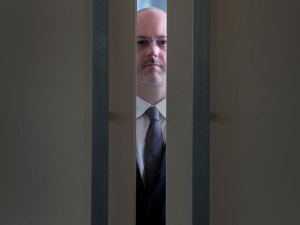By Tom Korosec & Andrew Harris
A plan by a court-appointed receiver to distribute assets recovered from R. Allen Stanford's Ponzi scheme
to investors was approved by a federal judge in Dallas.
U.S. District Judge David C. Godbey accepted the plan by Ralph Janvey, the receiver appointed in 2009 to marshal and liquidate Stanford's personal and business assets, to make a $55 million interim distribution to about 17,000 claimants, or about 1 cent for each of the $5.1 billion lost in the fraud scheme.
"We will follow it up in a subsequent distribution as the money comes in," Janvey's attorney, Kevin Sadler of Baker Botts LLP, told Godbey at a court hearing in April.
Ponzi scheme victims of Bernard L. Madoff, who was arrested in December 2008, recovered more than $5.4 billion. Clients of the MF Global Inc. brokerage were paid about $4.9 billion after its parent, MF Global Holdings Ltd., failed in October 2011. Victims of a scheme by Peregrine Financial Group Inc. founder Russell Wasendorf, who prosecutors last year said stole $215 million, received an interim distribution of $123 million.
A federal jury in Houston last year found Stanford, 63, guilty of lying to investors about the nature and oversight of certificates of deposit issued by his Antigua-based bank. The jurors decided he must forfeit $330 million in accounts seized by the U.S. government.
The SEC case is Securities and Exchange Commission v. Stanford International Bank, 09-cv-00298, U.S. District Court, Northern District of Texas (Dallas). The criminal case is U.S. v. Stanford, 09-cr-00342, U.S. District Court, Southern District of Texas (Houston).
To contact the reporter on this story: Andrew Harris in the Chicago federal courthouse at aharris16@bloomberg.net
To contact the editor responsible for this story: Michael Hytha at mhytha@bloomberg.net
U.S. District Judge David C. Godbey accepted the plan by Ralph Janvey, the receiver appointed in 2009 to marshal and liquidate Stanford's personal and business assets, to make a $55 million interim distribution to about 17,000 claimants, or about 1 cent for each of the $5.1 billion lost in the fraud scheme.
"We will follow it up in a subsequent distribution as the money comes in," Janvey's attorney, Kevin Sadler of Baker Botts LLP, told Godbey at a court hearing in April.
Ponzi scheme victims of Bernard L. Madoff, who was arrested in December 2008, recovered more than $5.4 billion. Clients of the MF Global Inc. brokerage were paid about $4.9 billion after its parent, MF Global Holdings Ltd., failed in October 2011. Victims of a scheme by Peregrine Financial Group Inc. founder Russell Wasendorf, who prosecutors last year said stole $215 million, received an interim distribution of $123 million.
A federal jury in Houston last year found Stanford, 63, guilty of lying to investors about the nature and oversight of certificates of deposit issued by his Antigua-based bank. The jurors decided he must forfeit $330 million in accounts seized by the U.S. government.
The SEC case is Securities and Exchange Commission v. Stanford International Bank, 09-cv-00298, U.S. District Court, Northern District of Texas (Dallas). The criminal case is U.S. v. Stanford, 09-cr-00342, U.S. District Court, Southern District of Texas (Houston).
To contact the reporter on this story: Andrew Harris in the Chicago federal courthouse at aharris16@bloomberg.net
To contact the editor responsible for this story: Michael Hytha at mhytha@bloomberg.net
STANFORD RECEIVERSHIP CERTIFICATION NOTICE
Before making distribution payments under the Interim Plan, the Receiver is required to send a Certification Notice to the Investor CD Claimants. This Certification Notice must ask each Investor CD Claimant for certification regarding whether they have applied for or received compensation for their claimed losses from sources other than the Receivership and, if so, the amount of such compensation. Investor CD Claimants must timely respond to this Certification Notice as a condition of receiving payment under the Interim Plan.
EXHIBIT B: CERTIFICATION NOTICE
Before making distribution payments under the Interim Plan, the Receiver is required to send a Certification Notice to the Investor CD Claimants. This Certification Notice must ask each Investor CD Claimant for certification regarding whether they have applied for or received compensation for their claimed losses from sources other than the Receivership and, if so, the amount of such compensation. Investor CD Claimants must timely respond to this Certification Notice as a condition of receiving payment under the Interim Plan.
EXHIBIT B: CERTIFICATION NOTICE
Read more: http://sivg.org/article/2013_Stanford_Judge_Approves_Interim_Distribution_to_Victims.html
Visit the Stanford International Victims Group - SIVG official forum http://sivg.org/forum/

